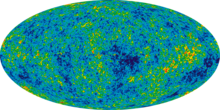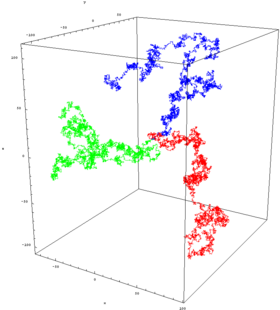
A | B | C | D | E | F | G | H | CH | I | J | K | L | M | N | O | P | Q | R | S | T | U | V | W | X | Y | Z | 0 | 1 | 2 | 3 | 4 | 5 | 6 | 7 | 8 | 9
| Part of a series on |
| Physical cosmology |
|---|
 |
In modern cosmological theory, diffusion damping, also called photon diffusion damping, is a physical process which reduced density inequalities (anisotropies) in the early universe, making the universe itself and the cosmic microwave background radiation (CMB) more uniform. Around 300,000 years after the Big Bang, during the epoch of recombination, diffusing photons travelled from hot regions of space to cold ones, equalising the temperatures of these regions. This effect is responsible, along with baryon acoustic oscillations, the Doppler effect, and the effects of gravity on electromagnetic radiation, for the eventual formation of galaxies and galaxy clusters, these being the dominant large scale structures which are observed in the universe. It is a damping by diffusion, not of diffusion.[1]
The strength of diffusion damping is calculated by a mathematical expression for the damping factor, which figures into the Boltzmann equation, an equation which describes the amplitude of perturbations in the CMB.[2] The strength of the diffusion damping is chiefly governed by the distance photons travel before being scattered (diffusion length). The primary effects on the diffusion length are from the properties of the plasma in question: different sorts of plasma may experience different sorts of diffusion damping. The evolution of a plasma may also affect the damping process.[3] The scale on which diffusion damping works is called the Silk scale and its value corresponds to the size of galaxies of the present day. The mass contained within the Silk scale is called the Silk mass and it corresponds to the mass of the galaxies.[4]
Introduction

Diffusion damping took place about 13.8 billion years ago,[6] during the stage of the early universe called recombination or matter-radiation decoupling. This period occurred about 320,000 years after the Big Bang.[7] This is equivalent to a redshift of around z = 1090.[8] Recombination was the stage during which simple atoms, e.g. hydrogen and helium, began to form in the cooling, but still very hot, soup of protons, electrons and photons that composed the universe. Prior to the recombination epoch, this soup, a plasma, was largely opaque to the electromagnetic radiation of photons. This meant that the permanently excited photons were scattered by the protons and electrons too often to travel very far in straight lines.[9] During the recombination epoch, the universe cooled rapidly as free electrons were captured by atomic nuclei; atoms formed from their constituent parts and the universe became transparent: the amount of photon scattering decreased dramatically. Scattering less, photons could diffuse (travel) much greater distances.[1][10] There was no significant diffusion damping for electrons, which could not diffuse nearly as far as photons could in similar circumstances. Thus all damping by electron diffusion is negligible when compared to photon diffusion damping.[11]
Acoustic perturbations of initial density fluctuations in the universe made some regions of space hotter and denser than others.[12] These differences in temperature and density are called anisotropies. Photons diffused from the hot, overdense regions of plasma to the cold, underdense ones: they dragged along the protons and electrons: the photons pushed electrons along, and these, in turn, pulled on protons by the Coulomb force. This caused the temperatures and densities of the hot and cold regions to be averaged and the universe became less anisotropic (characteristically various) and more isotropic (characteristically uniform). This reduction in anisotropy is the damping of diffusion damping. Diffusion damping thus damps temperature and density anisotropies in the early universe. With baryonic matter (protons and electrons) escaping the dense areas along with the photons; the temperature and density inequalities were adiabatically damped. That is to say the ratios of photons to baryons remained constant during the damping process.[3][13][14][15][16]
Photon diffusion was first described in Joseph Silk's 1968 paper entitled "Cosmic Black-Body Radiation and Galaxy Formation",[17] which was published in The Astrophysical Journal. As such, diffusion damping is sometimes also called Silk damping,[5] though this term may apply only to one possible damping scenario.[11][18][19] Silk damping was thus named after its discoverer.[4][19][20]
Magnitude
The magnitude of diffusion damping is calculated as a damping factor or suppression factor, represented by the symbol , which figures into the Boltzmann equation, an equation which describes the amplitude of perturbations in the CMB.[2] The strength of the diffusion damping is chiefly governed by the distance photons travel before being scattered (diffusion length). What affect the diffusion length are primarily the properties of the plasma in question: different sorts of plasma may experience different sorts of diffusion damping. The evolution of a plasma may also affect the damping process.[3]
Where:
- is the conformal time.
- is the visibility function, giving the probability that a CMB photon observed today last scattered at a conformal time . The quantity is the optical depth to Thomson scattering in the plasma, which is roughly the integrated number of scatterings undergone by a given photon.
- is the wave number of the wave being suppressed.[21]
- is the exponential damping envelope due to diffusion.
The damping factor , when factored into the Boltzmann equation for the cosmic microwave background radiation (CMB), reduces the amplitude of perturbations:
- is the conformal time at decoupling.
- is the "monopole of the photon distribution function"[2]
- is a "gravitational-potential in the Newtonian gauge". The Newtonian gauge is a quantity with importance in the General Theory of Relativity.[2]
- is the effective temperature.

Mathematical calculations of the damping factor depend on , or the effective diffusion scale, which in turn depends on a crucial value, the diffusion length, .[23] The diffusion length relates how far photons travel during diffusion, and comprises a finite number of short steps in random directions. The average of these steps is the Compton mean free path, and is denoted by . As the direction of these steps are randomly taken, is approximately equal to , where is the number of steps the photon takes before the conformal time at decoupling ().[3]
The diffusion length increases at recombination because the mean free path does, with less photon scattering occurring; this increases the amount of diffusion and damping. The mean free path increases because the electron ionisation fraction, , decreases as ionised hydrogen and helium bind with the free, charged electrons. As this occurs, the mean free path increases proportionally:
Antropológia
Aplikované vedy
Bibliometria
Dejiny vedy
Encyklopédie
Filozofia vedy
Forenzné vedy
Humanitné vedy
Knižničná veda
Kryogenika
Kryptológia
Kulturológia
Literárna veda
Medzidisciplinárne oblasti
Metódy kvantitatívnej analýzy
Metavedy
Metodika
Text je dostupný za podmienok Creative
Commons Attribution/Share-Alike License 3.0 Unported; prípadne za ďalších
podmienok.
Podrobnejšie informácie nájdete na stránke Podmienky
použitia.
www.astronomia.sk | www.biologia.sk | www.botanika.sk | www.dejiny.sk | www.economy.sk | www.elektrotechnika.sk | www.estetika.sk | www.farmakologia.sk | www.filozofia.sk | Fyzika | www.futurologia.sk | www.genetika.sk | www.chemia.sk | www.lingvistika.sk | www.politologia.sk | www.psychologia.sk | www.sexuologia.sk | www.sociologia.sk | www.veda.sk I www.zoologia.sk




















